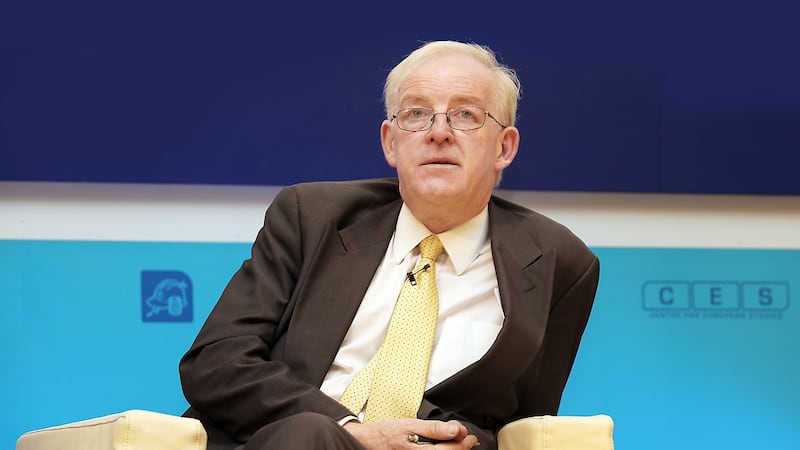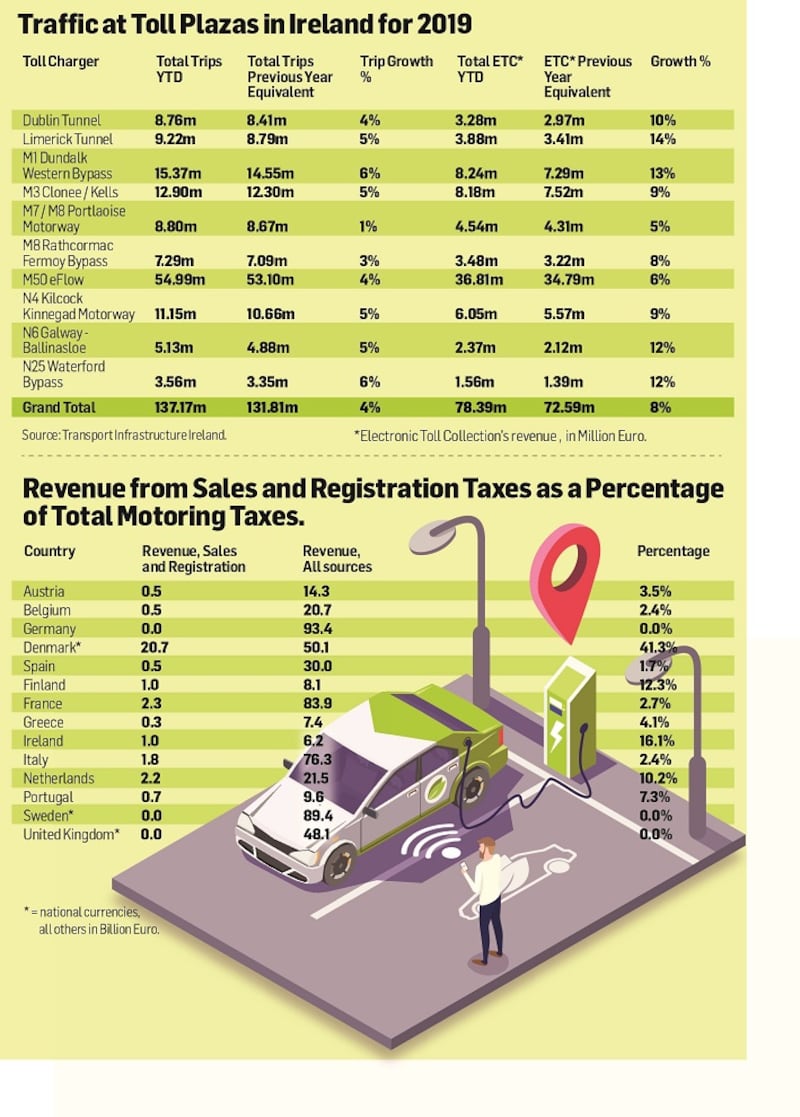The Irish motor tax system needs substantial reform if the State is to retain revenues coinciding with the country switching to widespread use of electric vehicles (EVs), according to analysis by leading economist Colm McCarthy.
In a report published on Monday, he concludes the current system based around taxes on fossil fuels is unsustainable, and threatens to eliminate a large part of the current annual revenue base of €6 billion.
Ultimately, the State will have to introduce a blend of electronic road-user charging combined with congestion charges to replace the taxes, he predicts.
In addition, the analysis suggests the Government target to put 936,000 EVs on Irish roads by 2030 is “unrealistic”, especially in light of external market factors beyond its control.

The report – commissioned by the Irish Car Carbon Reduction Alliance (ICCRA) which represents the majority of Irish car dealers and almost every brand – contends "a more realistic road map is needed for the successful decarbonisation of the Irish car fleet", including availing of increased carbon efficiency of fossil fuel vehicles in the transition period. It has been submitted to the Department of Finance's Tax Strategy Group.
The current level of tax on new cars is hindering motorists from switching to newer greener models, McCarthy says, “thereby facilitating rather than reducing carbon emissions”.
Reform is required to ensure maintenance and safety of Ireland’s road transport network, while aggregate revenue collected from motorists “does not appear to be excessive”.
Distortions
McCarthy details current distortions in the Irish car market separate to tax revenue vulnerability. The level of vehicle registration tax (VRT) is not only reducing new car sales, it is having a detrimental impact on the used market by inhibiting availability of two- and three-year-old models, he finds.
This is creating an artificial demand for used imports, which McCarthy says “is being met with older [higher emitting] UK models, with poorer fuel efficiency than the equivalent new variant”.

With the current tax system, the Irish purchaser of a used UK vehicle, at a specific price point, is paying less tax to the Irish Government than a purchaser of new vehicles at the same price, it finds. This is in a scenario where Irish cars have the highest emissions and are among the most expensive in the EU.
“There is an unintended incentive to encourage the importation of older, high-emission vehicles from the UK, the only other European country with right-hand steering wheels.”
Under the 2019 Climate Action Plan (Cap), the Government proposes to ban the sale of petrol and diesel cars by the end of the decade when only zero-emission cars and no internal combustion engine (ICE) vehicles will be available for sale. Yet, EVs are just 3.5 per cent of new car sales while European manufacturers are working towards an EU deadline of 2040; there are some 19,000 EVs in the country.
EVs will not be available in the quantity required to allow such a transition until the late 2020s, the report concludes. "The likelihood is that the adoption in Ireland of electric passenger cars is not going to happen at an appreciable pace until 2026 and later years."
The Cap states one-third of new cars sold over the decade must be battery EVs or plug-in hybrids, “implying that the new car market would reach over 200,000 units. It reached just 117,000 in the most recent year of 2019, and there is no reason for expecting a plentiful supply of used electric imports.
“Even with the €5,000 grant and remission of VRT, electric cars are not price competitive and manufacturers’ prices are unlikely to fall significantly until production at scale becomes feasible. This may not happen until the mid-2020s and the intermediate Cap target of 180,000 on the road by 2025 is optimistic.”
The Tesla 3, a popular electric model in Ireland, costs €47,000 for the basic version, after subsidies, but “the volume new car market” is located at a price point closer to €30,000, McCarthy says.
Fast chargers
The availability of fast chargers is also a serious constraint. A €10 million grant to the ESB from the Climate Action Fund last year will finance fast chargers at 140 locations, which compares with 1,500 filling stations nationwide for petrol and diesel.
“Fast chargers can deliver about 100km of driving range in six minutes ... Until this level of service reaches availability comparable to the filling station network, the attractions of electric vehicles for non-urban drivers will be limited.”
Unless available “as extensively as liquid fuel”, EV take-up even when they become price competitive will be inhibited.
In such circumstances, McCarthy says the practical option for the years immediately ahead is recasting motoring taxes “in a manner designed to encourage fleet replacement with more fuel-efficient petrol and diesel models” – with discernibly less emissions than the older models currently on Irish roads.
This approach is with a view to the ending of sales of petrol and diesel cars by 2040. This is in line with what other EU countries are working towards, to which all major car manufacturers are already committed, and is backed by EU legislation “as a viable long-term solution to making roads emissions free”.
“Decarbonisation of the vehicle fleet will progressively undermine the revenue base for fuel taxes, currently the principal revenue raiser, and the Irish system of taxes on vehicle acquisition has perverse effects in a context where fleet conversion is public policy,” he underlines.
Fuel taxes
In assessing the tax approach, McCarthy says Ireland is heavily reliant on fuel taxes and VRT, "which is discouraging the purchase of new cars". Most European countries have substantial fuel taxes but few share Ireland's reliance on upfront taxes on vehicle acquisition, while direct charging for use of road transport infrastructure has become more widespread in Europe.
On direct (construction, maintenance, and policing) costs of the road system and indirect costs, such as carbon emissions, low-level non-carbon emissions (air pollution arising mainly from diesel vehicles) and congestion externalities, it concludes “non-carbon and congestion externalities are significant and yet not recovered from motorists”.
In addition, the structure is not well aligned with incentivisation of emission reduction and fleet replacement, McCarthy says. “As the fleet becomes electrified, and as electricity moves to zero- or low-carbon technologies, the current reliance on fuel taxes, over half of revenue from all sources, becomes problematic.”
Substantial revenue must be maintained to cover the direct and indirect costs of motoring, even if carbon emissions are reduced, he says.
The McCarthy report says “a radically different approach to raising revenue from road users is becoming inevitable”, and favours a blend of electronic road pricing and congestion charging. The Government should “undertake a detailed study of the practicalities of introducing a comprehensive system of road-user charging in Ireland”.
“It is impossible to undertake a shift to user-charging quickly but it is also not necessary. Revenue can be protected through the transition even if the ultimate destination is identified as direct road-user charging.”
Road space charges
Through charging for road space, it would restore the competitive advantage of bus-based public transport which is suppressed at present where road space is effectively free. During the transition, which could take a decade or more, the system of motoring taxes should seek to protect aggregate revenue while promoting fleet replacement.
He cites options including charge by weight and distance – differentiated by vehicle type – related to carbon emissions. A charge to cover congestion costs could be differentiated by location and time of day. Tolls are the closest approximation to a use-related charge in Ireland but they generate only 5 per cent of revenue, and are “not well designed”.

















